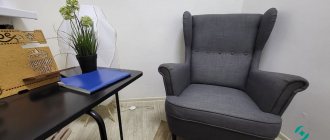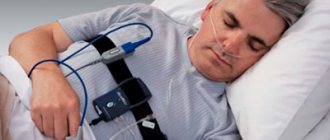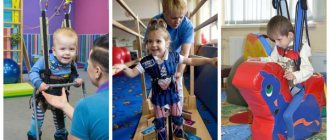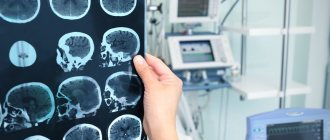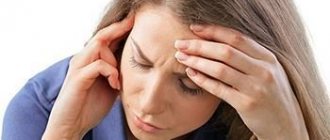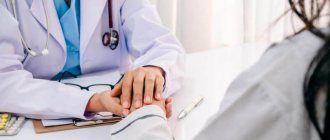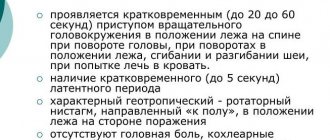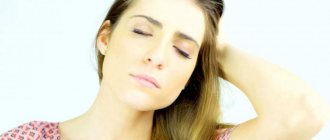Dizziness and vestibular disorders are related. The human vestibular apparatus is located in the inner part of the hearing organ. The human vestibular apparatus has receptors that are very sensitive and immediately detect any changes in body position. Vestibular vertigo creates a sensation of imaginary rotation of objects around the patient. Most often it is caused by certain damage to the vestibular apparatus; dizziness occurs as a result of damage to the central or peripheral parts of the vestibular analyzer. Other types of dizziness are associated with various diseases and are not related to damage to the vestibular system.
At the Yusupov Hospital they diagnose diseases that cause vestibular vertigo. In the hospital you can undergo examination, treatment and recovery in a rehabilitation clinic. The clinic carries out rehabilitation measures, uses therapeutic exercises, and various types of physiotherapeutic procedures. Instructors select exercises on simulators for patients suffering from dizziness. The vestibular apparatus, which is treated using various methods, is restored in 50-80% of patients after treatment and rehabilitation.
General information
Vestibulopathy is a disorder of the normal functioning of the vestibular apparatus , in which characteristic symptoms appear.
The ICD-10 code for vestibulopathy is H81 (Vestibular function disorders). The normal orientation of a person in space and his balance in a vertical position is ensured by the vestibular apparatus. Disturbances in its work lead to a person experiencing confusion, dizziness , and the inability to remain in a standing position. This condition is also called labyrinthopathy. It can develop due to various reasons and diseases, developing at any age in every person. Sometimes vestibulopathy is a congenital pathology.
It may manifest itself as a separate syndrome or as a sign of neuropsychiatric disorders. In the second case, it is more difficult to treat this disease. How this pathology manifests itself, and what treatment methods are advisable to practice, will be discussed in this article.
Pathogenesis
Vestibular insufficiency can occur at any age. Sometimes this is a congenital pathology. The pathological process is localized in the inner ear. The vestibular apparatus, which is a complex receptor of the vestibular analyzer, consists of three arches. They are located at an angle of 90 degrees to each other. They contain liquid, which is distributed through the channels depending on the position of the human body, gravity, the force of attraction, as well as the influence of a number of other factors. The brain receives impulses that determine the movements of different parts of the body. Vestibular insufficiency develops when the functioning of the vestibular apparatus is impaired.
Vestibulopathy can develop with a variety of pathogenetic variants of damage to the peripheral or central part of the vestibular analyzer, which performs three important functions - maintaining balance, spatial orientation, and image stabilization.
Treatment
Treatment of the vestibular apparatus is a difficult task, as it depends on the causes of organ damage, the age of the patient, and the presence of concomitant diseases.
Pills
- Anticholinergics – prevent the development of dizziness. They have a lot of side effects. Elderly people are prescribed with caution, as they can provoke psychosomatic disorders. "Relanium", "Vestibo".
- Antihistamines – relieve dizziness and related symptoms. Representatives of this group are “Betaserc”, “Betagistin”.
- Benzodiazepines – eliminate dizziness and associated nausea. They have side effects and can cause addiction. These include Lorazepam, Diazepam.
- Antiemetics - relieve acute attacks, but are prescribed for a single dose, as they can cause muscle dystonia.
- Vasodilators - have a weak antihistamine effect, reduce the excitability of the vestibular apparatus. Cinnarizine is often prescribed.
In acute cases, vestibular dizziness is subject to drug therapy prescribed by a specialist.
Gymnastics
A fairly effective way to restore the proper functioning of the vestibular apparatus is special physical exercise. They not only give long-lasting results, but can also completely eliminate the disease. The main condition is that the set of exercises must be developed by the attending physician, since independent gymnastics can have the opposite effect.
ethnoscience
Homemade remedies can be used to prevent pathology and also complement traditional medicine. The most effective are tinctures made from ginger, meadow clover, and propolis. Stimulation of puncture points on the hands gives good results. If you feel dizzy, just rub a round object (stone, walnut, massage ball) in your palms.
Self-therapy for an unspecified disease can provoke a deterioration in the patient’s condition.
Diseases of the vestibular apparatus reduce a person’s performance and disrupt his orientation in space. To prevent the development of pathology, doctors recommend leading a healthy lifestyle, moving more, doing yoga, avoiding loud sounds and frequent flights. When the first symptoms appear and their progression, you should immediately contact a neurologist.
Classification
Depending on the nature of its origin, vestibulopathy is divided into several types:
- Vertebrogenic – develops against the background of pathologies of the cervical spine. It can be observed with osteochondrosis , osteoporosis , intervertebral hernia , etc. This form is the most common. This condition is characterized by prolonged dizziness and a feeling of head instability. When trying to focus your gaze on moving objects, discomfort occurs. Spontaneous attacks of eye rotation may occur when a person tries to turn his head sharply. They last no longer than 30 seconds.
- Peripheral - develops as a consequence of the inflammatory process in the nerve ganglia in the inner ear. Most often this occurs due to allergies or infections. With such a lesion, in addition to vestibular disorders, the patient may experience tinnitus and causeless fear. Prolonged dizziness and bouts of eye rolling are noted.
- Central - develops if disturbances occur in the function and structure of the vestibular nuclei of the medulla oblongata and cortex.
- Post-traumatic – develops after traumatic brain injury if hemorrhage occurs in the labyrinth of the inner ear. As a result, tissue damage is noted. The eardrums may also be damaged, and the ganglia of the brain may be shaken and damaged. In this case, both dizziness and other characteristic signs are noted - spontaneous eye movements, nausea, vomiting. In addition, a patient with such a lesion has an unstable gait - it is difficult for him to stand on his feet.
Cochleovestibular syndrome is also distinguished . In this condition, auditory and vestibular function is impaired. Cochleovestibular disorders are accompanied by tinnitus, hearing loss, dizziness, and imbalance.
The main causes of vestibular vertigo and methods of their diagnosis
Most often, dizziness occurs due to damage to the vestibular system. The nature of dizziness and its severity in such cases will depend on the severity of the injury, the presence of unilateral or bilateral damage, and the speed of development of the pathological process. The most striking is dizziness caused by acute unilateral damage to the vestibular system at the peripheral (inner ear, vestibular nerve) or central (vestibular nuclei and their connections with other parts of the central nervous system) level. Such dizziness is often expressed in a sensation of rotation or movement of surrounding objects or the patient himself in space, accompanied by severe instability, nausea, and vomiting. It is more difficult to diagnose bilateral vestibular lesions (eg, bilateral vestibulopathy due to ototoxic antibiotics) or diseases that cause slow and gradual damage to the vestibular system (eg, schwannoma of the vestibulocochlear nerve). In these cases, instead of severe systemic dizziness, patients may experience more or less pronounced instability or some discomfort in situations that require particularly coordinated work of the vestibular system (for example, when moving on an escalator, in open spaces or in large stores). At the initial stage of the disease or with minor damage to the vestibular system, instability can be very slight. In such cases, a standard neurological examination may not reveal abnormalities, and the doctor gets a false impression about the psychogenic nature of the disease. A special clinical otoneurological examination, as well as instrumental diagnostics using videonystagmography, electrocochleography, rotating chair and other modern methods of examining the vestibular system allows not only to timely identify damage to the vestibular system, but also often to determine its level and possible causes.
Despite the huge variety of diseases of the vestibular system, most cases are caused by only a few main nosologies. Damage to the peripheral part of the vestibular analyzer is most often caused by benign paroxysmal positional vertigo (BPPV), Meniere's disease and vestibular neuronitis. Damage to the central part of the vestibular analyzer is usually caused by a violation of cerebral circulation in the vertebrobasilar system or vestibular migraine.
BPPV is a disease of the labyrinth, which is manifested by attacks of vestibular vertigo that occur when the position of the head changes. The disease is caused by the appearance in the semicircular canals of otolith particles freely moving or (less commonly) fixed on the cupula of the ampullary receptor. The diagnosis of BPPV is confirmed by performing positional tests, of which the Dix-Hallpike test is the most commonly used. The sensitivity and specificity of this test are especially high when using video glasses that prevent the patient from fixating the gaze, which greatly facilitates the visualization of the positional nystagmus typical of BPPV. Careful analysis of nystagmus during positional tests allows you to avoid errors in the differential diagnosis of BPPV and central positional nystagmus. The latter is much less common, but can be a sign of extremely dangerous diseases, such as, for example, a tumor of the posterior cranial fossa. Meniere's disease is an idiopathic disease of the inner ear, characterized by periodic attacks of systemic vertigo, tinnitus and the development of sensorineural hearing loss. The etiology of the disease is not clear, and the pathogenesis is explained by the formation of the so-called endolymphatic hydrops - a condition caused by an increase in the pressure of the endolymph filling the membranous labyrinth of the inner ear. Diagnosis of Meniere's disease is based not only on clinical data, but also on instrumental examination: tone threshold audiometry, which allows identifying low-frequency sensorineural hearing loss characteristic of this disease, and electrocochleography, a study that reveals indirect signs of endolymphatic hydrops.
Vestibular neuronitis is the third most common cause of acute vestibular vertigo after benign paroxysmal positional vertigo and Meniere's disease. The disease is associated with selective inflammation of the vestibular nerve caused by the herpes simplex virus type 1. Diagnosis of acute unilateral peripheral vestibulopathy, which underlies vestibular neuronitis, is carried out using videonystagmography, which reveals unidirectional horizontal nystagmus, and a caloric test, which establishes asymmetry during cold and heat stimulation of the inner ear. Modern instruments for caloric testing allow for both water and air calorization, which makes it possible to perform this study even in patients with eardrum defects.
Migraine-associated dizziness occurs in attacks and can be moderate or severe. Often (but not always) dizziness in such cases is accompanied by a migraine headache. The diagnosis of vestibular migraine is established based on the clinical picture and the exclusion of other diseases of the vestibular system. The latter is impossible without modern instrumental examination: video or electronystagmography, tone threshold audiometry, vestibular evoked myogenic potentials, MRI and CT.
Stroke and transient ischemic attack in the arteries of the vertebrobasilar system can also cause dizziness. As a rule, dizziness in such cases is accompanied by other focal neurological symptoms, such as diplopia, dysphagia, dysphonia, hemiparesis, etc. In rare cases, when limited areas of the brain stem and cerebellum are affected, isolated dizziness may occur. Differential diagnosis of such dizziness with diseases of the peripheral vestibular system is very difficult and requires MRI of the brain, careful analysis of videonystagmography, as well as dynamic observation.
Thus, the diagnosis of vestibular diseases requires the doctor to know not only the clinical picture of various lesions of the vestibular system, but also the capabilities of modern instrumental diagnostics of vestibular diseases. The methods of instrumental diagnostics of the state of the vestibular system available today often make it possible not only to establish the level of damage to the vestibular system, but also to identify the cause of the disease.
In this regard, it seems especially relevant to organize specialized rooms equipped with modern equipment for diagnosing vestibular disorders: videonystagmograph VN425, Interacoustics A/S, Denmark (allows, in particular, to objectify nystagmus and evaluate visual suppression of nystagmus, conduct research on visual saccades, smooth pursuit eye movements and optokinetic nystagmus), a device for electrocochleography Eclipse EP25, Interacoustics A/S, Denmark (allows to diagnose endolymphatic hydrops - a condition underlying Meniere's disease), a device for recording evoked vestibular myogenic potentials Eclipse VEMP, Interacoustics A/S, Denmark (allows test otolithic function), stabilometric platform (allows not only to diagnose vestibulospinal reflex disorders, but also to carry out vestibular rehabilitation based on the biofeedback method). The experience of such offices (both in Russia and abroad) indicates a significant increase in the efficiency of diagnosis and treatment of vestibular disorders when examining a patient in specialized “dizziness centers.”
Causes of vestibular apparatus disorders
The causes of dysfunction of the vestibular apparatus can be very different. Basically, vestibulopathy is provoked by the following factors:
- Cervical osteochondrosis - due to displacement of discs and vertebrae, the functioning of the vertebral artery is disrupted, which impairs blood supply. In addition, with osteochondrosis, the nerves are pinched, which also leads to dysfunction of the vestibular apparatus. Also, problems with the vestibular apparatus can be observed with intervertebral hernia, osteoporosis, etc.
- Pathologies of the inner ear - this may be a violation of lymph flow in the middle ear, inflammatory processes, otitis media, etc.
- Labyrinthitis is an inflammatory disease that provokes the development of periodic dizziness.
- Meniere's disease - during the development of the disease, pathological changes in the inner ear are noted.
- Infarction of the labyrinth – leads to impairment of hearing and function of the vestibular apparatus.
- Vestibular neuronitis is a consequence of herpetic damage to nerve fibers. If a person is diagnosed with vestibular neuronitis, it should be taken into account that signs of the disease appear periodically - during exacerbation. As a rule, this happens in spring and autumn. Also, vestibular neuritis can develop as a consequence of acute respiratory infections, influenza , etc.
- Migraine - with this disease, the symptoms are similar to vestibulopathy, but the hearing does not change.
- Diseases of the central nervous system - can cause pathological processes in the membranous labyrinth.
- Traumatic damage to the thin bone membranes of the labyrinth , in which the eardrum ruptures or hemorrhage in the middle ear - this can happen with severe coughing, straining, diving.
- Vertebrobasilar insufficiency - manifests itself mainly in older people, causing damage to the vestibular analyzers. With this pathology, the blood vessels, cerebellum and brain stems are affected. The duration of such an attack is several minutes, during which the person loses balance and orientation in space, he develops weakness, and his limbs go numb.
- Intoxication of the body due to taking certain medications.
- Neurotic disorders.
- Neuromas are tumors that form and grow from nerve cells.
- Occupational diseases – working in conditions of constant vibration or noise.
Symptoms of vestibulopathy
The basis of vestibulopathy are four main symptoms:
- systemic dizziness;
- vegetative manifestations - nausea, vomiting, hyperhidrosis , heart rate disturbances, etc.;
- imbalance;
- spontaneous nystagmus .
However, disorders of the vestibular system can manifest themselves differently in different diseases. Therefore, it is important to pay attention to the following manifestations:
- I feel dizzy from time to time, and this symptom occurs quite often.
- Difficulties appear in maintaining balance - it seems that the body “does not obey” while walking or trying to move.
- Vision deteriorates, spots and goosebumps appear in the eyes.
- of migraines increases .
- Hearing deteriorates, tinnitus bothers me.
- Nystagmus is periodically observed - the movement of the eyeballs in one direction.
- Periodic nausea and vomiting.
If a person does not know what vestibular neuritis and how it manifests itself, then he can ignore the symptoms of vestibular neuritis for a long time, believing that these are just signs of overwork.
Exercises for vestibular vertigo
Dizziness often occurs when turning the head or body - this forces patients to try to avoid such movements. Gymnastics for patients with vestibular system disorders includes various types of exercises, including exercises with head and body turns. Exercises can be performed while sitting on a bed, with or without a pillow, sitting on a chair, or standing. The exercises are based on the principle of sensory mismatch between the movements of the eyes, torso and head. Special simulators that work on the principle of biofeedback will help increase the effectiveness of gymnastics. During the training period, you should avoid taking sedatives and alcohol.
Tests and diagnostics
To establish a diagnosis, the patient must see a doctor, who first conducts a detailed survey and examination. Further, if necessary, further studies will be prescribed.
The study of the vestibular apparatus can be carried out using different methods. There are three main tests to check how the vestibular apparatus works: rotational , thermal and mechanical . In addition, you can undergo simple testing to determine the presence of coordination disorders.
With the help of such tests, a study of the functions of the vestibular apparatus for VVC in Moscow (Khimki, etc.) and other cities is carried out.
- Rotation test - to conduct it, a person sits in a chair and tilts his head forward. After this, 10 rotations are carried out over 20 seconds, then the chair suddenly stops. After this, nystagmus develops. Having measured its duration, the procedure is repeated again with rotation in the opposite direction. Normally, nystagmus will last the same amount of time - 20-50 seconds. If the difference between the two results is 25%, then we can talk about balance disorders.
- Mechanical examination - for this purpose, a rubber bulb is used, with the help of which the external auditory canal is filled with oil to displace the air from it. Next, the pear is compressed and unclenched, checking for damage to the bone capsule of the labyrinth.
- Thermal examination - the patient's ear canals are washed with water for 30 seconds.
At this time, nystagmus occurs, and assessing its duration makes it possible to determine the sensitivity of the vestibular apparatus.
Tests are carried out to determine coordination. This could be walking in a straight line with your eyes closed, trying to touch the tip of your nose with your eyes open and closed, etc.
There are other tests to determine whether the vestibular apparatus is weak or strong.
- Nystagmus can be measured using so-called Frenzel glasses . These are special magnifying glasses with bulbs equipped with light bulbs that illuminate the eyes.
- Also for this purpose, the method of electronystagmography - measuring nystagmus using electrodes.
- A neurological examination is also carried out, aimed at determining the condition of the nerve trunks of the eyeball and the muscles of the facial skull.
- MRI allows you to determine the condition of the spine.
- The inner ear and eardrum are also examined.
Other studies may be prescribed. The doctor will tell you during the consultation where to undergo such a study and what the conclusion looks like.
Bibliography
- "Biological encyclopedic dictionary." Ch. ed. M. S. Gilyarov; Editorial team: A. A. Babaev, G. G. Vinberg, G. A. Zavarzin and others - 2nd ed., corrected. - M.: Sov. Encyclopedia, 1986.
- "Otorhinolaryngology". Textbook ed. I.B. Soldatov and V.R. Hoffman. – St. Petersburg, 2000. – p.41-45, p.75-96.
- Soldatov I.B. "Lectures on otorhinolaryngology: Textbook." – M.: Medicine, 1994. – pp. 40-56., pp. 261-277.
- How the vestibular apparatus works - https://theoryandpractice.ru (Access date: 07/01/2019)
- How to train the vestibular apparatus at home - www.sovsport.ru (Date of access: 07/02/2019)
Treatment with folk remedies
Some folk remedies can be used as auxiliary methods during the period of treatment and recovery for vestibulopathy.
- Melissa tea . 1 tbsp. l. Dried lemon balm pour 1 cup boiling water. After 10 minutes, drink with honey. It is recommended to drink this tea for dizziness twice a day.
- Infusion of parsley seeds . Finely grind parsley seeds, 1 tsp. pour the raw material into 1 glass of water and leave for 8 hours. Drink 50 ml 4 times a day.
- Infusion of nettle leaves . 1 tbsp. l. Pour dry nettle leaves into a thermos and pour 200 ml of boiling water. After two hours, strain by squeezing out the nettle leaves. Combine the resulting liquid with the same amount of fresh apple juice. Drink throughout the day. Take for two weeks.
- Essential oils . Mix 50 ml of camphor oil with 25 ml of fir oil and 10 ml of juniper. Mix thoroughly and lubricate the lymph nodes on the neck, nose and mouth with the resulting product. Please note that this product should not be applied to open wounds.
- Infusion of mistletoe and Japanese Sophora . The dry raw materials of both plants need to be crushed and mixed with 15 g of each component. Pour 500 ml of boiling water. When the product is infused, drink 100 ml before meals.
Eye tracking
Sit in a comfortable position, take in your hand a small (the size of a postcard or map) thick piece of paper with a few words printed on it in regular font. Hold a piece of paper 30 cm away at eye level. Move the piece of paper horizontally to the right and left. Repeat the exercises, moving the sheet vertically, then diagonally. During the exercise, the head should remain motionless; you need to follow the leaf only with your eyes. Over time, move the piece of paper faster and faster until you can no longer make out the words written on it.
In each plane you need to repeat the exercise 15–20 times.
Prevention
The following prevention methods should be practiced:
- Limit situations that provoke an attack of vestibulopathy.
- Eat right, avoiding lack of vitamins and minerals. If necessary, take vitamin-mineral complexes periodically.
- Get proper rest, sleep at least 7 hours a day.
- To refuse from bad habits.
- Exercise daily, do yoga, Pilates, swimming.
- Treat bacterial and viral diseases in a timely manner.
- If vestibulopathy occurs, consult a doctor.
Diet
Salt-free diet
- Efficiency: 5-10 kg in 13 days
- Time frame: 13 days
- Cost of products: 4500-8000 rubles for 13 days
For some diseases that provoke vestibulopathy, it is recommended to adhere to a salt-free diet or limit the amount of salt in the menu.
In general, nutrition should be rational and varied, and the diet must include fresh fruits and vegetables, meat, fish, dairy products, nuts, and vegetable oils.
You should give up alcohol.
Consequences and complications
A severe complication of vestibulopathy can be purulent labyrinthitis , which, in turn, sometimes develops into meningitis . Therefore, inflammation in the inner ear must be treated under the close supervision of a doctor.
Vestibulopathy, moreover, negatively affects the overall quality of life. Dizziness and migraines impair work ability. In addition, such manifestations can cause accidents and traffic accidents.
In advanced stages, the auditory nerve may be affected, leading to the development of hearing loss.
This condition can also lead to cognitive impairment.
Treatment of vestibulopathy at NIKIO
Despite the severity of symptoms, the prognosis of the disease is favorable. In most cases, the patient is completely cured, so there is no need to worry if you notice signs of vestibulopathy. You should immediately seek help from a specialized clinic. Research Clinical Institute of Otorhinolaryngology named after. L.I. Sverzhevsky in Moscow is equipped with the most modern equipment, and doctors have many years of experience, which allows our patients to count on a complete examination and accelerated recovery
List of sources
- Zamergrad M.V., Grachev S.P., Gergova A.A. Acute vestibular vertigo in old age: stroke or peripheral vestibulopathy. Journal of Neurology and Psychiatry. S.S. Korsakov. Special issues. 2018; 118(6-2): 46-49.
- Parfenov V.A., Abdulina O.V., Zamergrad M.V. Differential diagnosis and treatment of vestibular vertigo // Neurology, neuropsychiatry, psychosomatics. - 2010. - No. 2. - P. 49-54.
- Suslina Z.A., Varakin Yu.Ya., Vereshchagin N.V. Vascular diseases of the brain. M. 2006.
Vestibular vertigo: symptoms and treatment in older people
Dizziness (vertigo) is manifested by the illusion of rapid rotation of objects around the patient. It may be accompanied by vomiting, nystagmus, nausea, and ringing in the ears. When vestibular vertigo develops in older people, the causes can be varied: lack of blood supply to the brain (cerebral ischemia), multiple sclerosis, head injuries, some types of brain tumors, tumors of the auditory nerve, hormonal imbalance, atherosclerosis, and other disorders. Treatment of vestibular vertigo (vertigo) in older people begins with finding the cause of the dizziness and treating the underlying disease. Vestibular gymnastics for dizziness in older people improves well-being, has a beneficial effect on the heart, musculoskeletal system, and nervous system. Treatment of vestibular vertigo is carried out with the help of drug therapy, physiotherapy, physical therapy, and reflexology.

